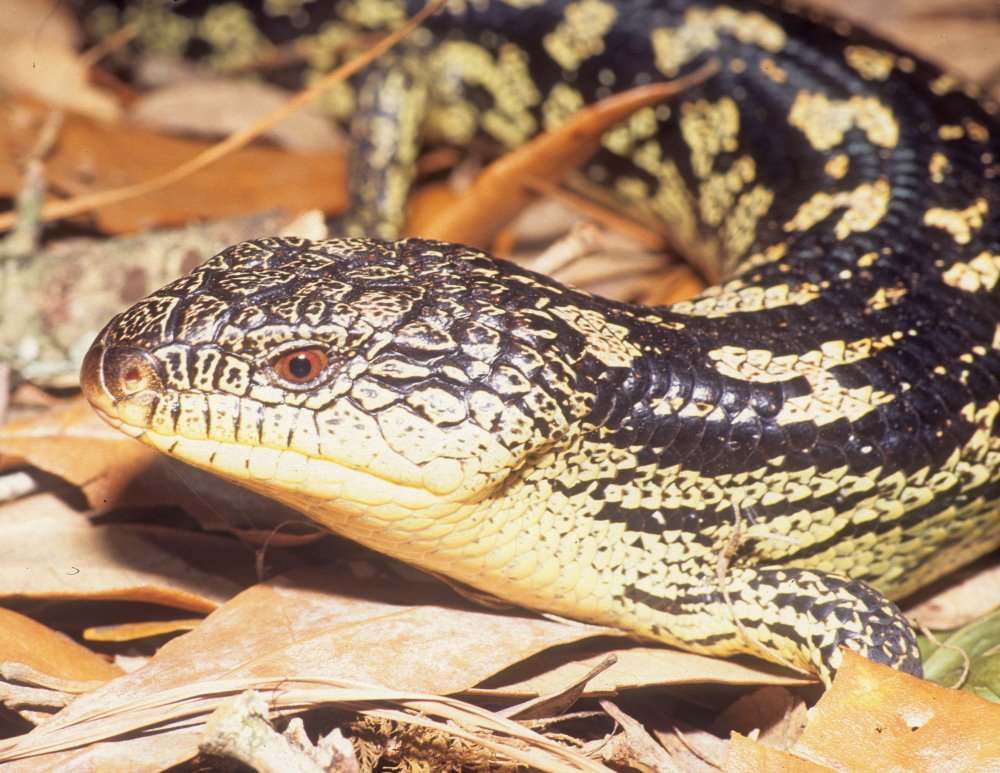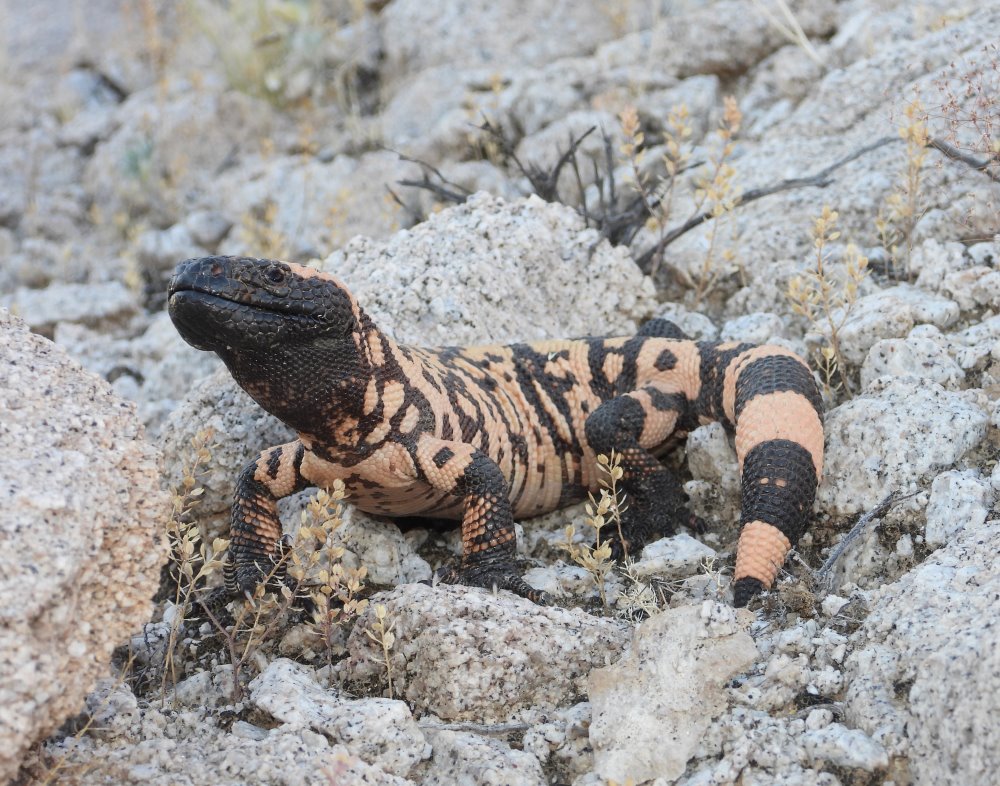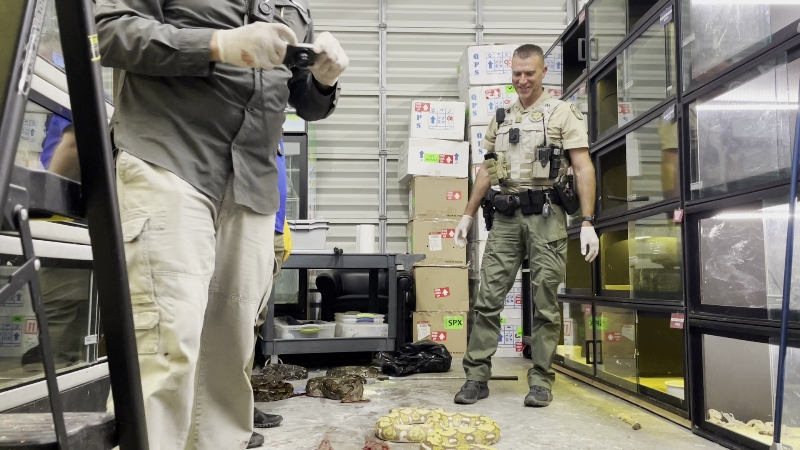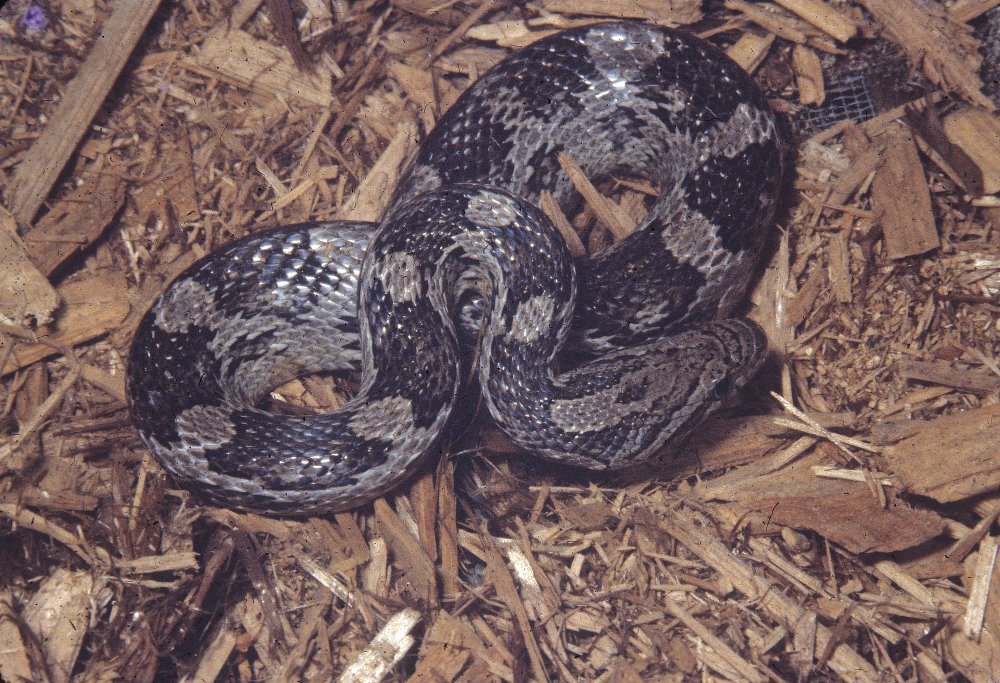Reptile & Amphibian
News Blog
Keep up with news and features of interest to the reptile and amphibian community on the kingsnake.com blog. We cover breaking stories from the mainstream and scientific media, user-submitted photos and videos, and feature articles and photos by Jeff Barringer, Richard Bartlett, and other herpetologists and herpetoculturists.
Friday, April 28 2023
Happy Rattlesnake Friday! Check out this gorgeous pair of Sidewinders in our herp photo of the day uploaded by kingsnake.com user dvenom05 . Remember that on Rattlesnake Friday, we celebrate all our venomous creatures! Be sure to tell them you liked it here!

Upload your own reptile and amphibian photos photos at gallery.kingsnake.com, and you could see them featured here!
Thursday, April 27 2023
This Tiger Salamander shows it is a good herping day in our herp photo of the day uploaded by kingsnake.com user TJ.! Be sure to tell them you liked it here!

Upload your own reptile and amphibian photos at gallery.kingsnake.com, and you could see them featured here!
Wednesday, April 26 2023
This sassy lil watersnake had to stop and eat a toad in the yard before the photographer captured it for our herp photo of the day uploaded by kingsnake.com user dinahmoe ! Be sure to tell them you liked it here!

Upload your own reptile and amphibian photos at gallery.kingsnake.com, and you could see them featured here!
Tuesday, April 25 2023
This Savu is coming in for it's close up in our herp photo of the day, uploaded by kingsnake.com user chefdev is all amphibian! Be sure to tell them you liked it here!

Upload your own reptile and amphibian photos at gallery.kingsnake.com, and you could see them featured here!
Monday, April 24 2023
Although often called incorrectly a rubber eel, this Rio Cauca Caecilian ( Typhlonectes natans) in our herp photo of the day, uploaded by kingsnake.com user chrish is all amphibian! Be sure to tell them you liked it here!

Upload your own reptile and amphibian photos at gallery.kingsnake.com, and you could see them featured here!

Not brightly colored, but IMO the finest of the Blue Tongues, Tiliqua nigrolutea.
Having well over 300 skink species, Australia could also be known as the “Great Land of Skinks.” These range in size from 4” long Garden Skinks and Pygmy Blue-Tongued Skinks to the remaining 5 species, all bulky blue-tongued species of the genus Tiliqua (one (possibly 2) additional species are extralimital). The Australian species are the Blotched, Common, Centralian, and Western Blue-tongues, and the Stump-tailed Skink, this latter now being considered one of the Blue-tongued skinks. These 5 vary individually within species from 16 to 23 inches in overall adult length.
Although we have kept several species, it is the Blotched Blue-tongue, Tiliqua nigrolutea, that is my favorite. Additionally, I favor the black (ground color) and buff (dorsal blotches and lateral reticulations) of the montane form over the paler colors of the lowland forms. Both forms are heavy-bodied, short-legged, diurnal, terrestrial, adult at 16-20”, live-bearing, long-lived (~20 years), placid, and hardy.
This skink adapts well to varying temperatures as well as eagerly accepting a wide variety of food items. Ours ate fruits, vegetables, canned dogfood, softened kibbled dog food, and they loved snails, slugs, and nightcrawlers. They often fold the hindlegs back towards the tail when moving about.
Females produced a single clutch annually, neonates numbering 3 to 8.
If you like responsive, hardy, captives, and if they are ever again legally available and affordable, consider a Blotched Blue-tongue. I don’t think you will be unhappy with the choice.
Continue reading "Blotched Blue-tongued Skinks"
Friday, April 21 2023
Happy Rattlesnake Friday! To end the week, this Jackson's Tree Snake ( Thrasops jacksonii) comes in to represent rear-fangs for our Herp Photo of the day, uploaded by kingsnake.com user Claus ! Be sure to tell them you liked it here! As always on Friday, we celebrate all of our venomous reptiles for their contribution to the world.

Upload your own reptile and amphibian photos at gallery.kingsnake.com, and you could see them featured here!
Thursday, April 20 2023
The Northern Leopard frog ( Lithobates pipiens) is an fairly widespread US Native species that get a spotlight in our herp photo of the day, uploaded by kingsnake.com user Terry_Cox!

Upload your own reptile and amphibian photos at gallery.kingsnake.com, and you could see them featured here!
Wednesday, April 19 2023
Everyone feels just like this little chameleon does here in our herp photo of the day uploaded by kingsnake.com user 1Sun every once in a while! Be sure to tell them you liked it here!

Upload your own reptile and amphibian photos at gallery.kingsnake.com, and you could see them featured here!
Tuesday, April 18 2023
Welome this little Chondro in our Herp Photo of the day to the world, uploaded by kingsnake.com user MikeRusso! Be sure to tell them you liked it here!

Upload your own reptile and amphibian photos at gallery.kingsnake.com, and you could see them featured here!
Monday, April 17 2023
What a stunning boa in our herp photo of the day, uploaded by kingsnake.com user Sharkman20 ! Be sure to tell them you liked it here!

Upload your own reptile and amphibian photos photos at gallery.kingsnake.com, and you could see them featured here!

This beautiful subadult Banded Gila Monster was just perched along a rocky trail.
The Gila (pronounced Hee-laa) Monster, Heloderma suspectum, is famous for its venomous bite. It is the only venomous lizard in the USA.
I find them appealing both for their appearance and the fact that they are unpredictable in their appearances in areas as different as rocky deserts, mountain slopes, and heavily populated areas. I rarely find them when I’m looking for them. But when I’m not actively looking, I may stumble across one or two.
This is a long lived lizard. A life span of 20 to 30 years is often quoted, but one researcher has been observing and documenting the same Gila Monster in her (he has determined it to be a female) on her winter refuge for more than 40 years. That’s right, 40+ years for that matriarch!
To highlight their unpredictability, on a recent trip to California, Jake and I had failed to find the White rattlesnake we had hoped to photograph and were returning to the car along our different trails. Suddenly Jake gave a holler, saying “come look at this!”
I clambered over to where Jake stood, and there amid the rocks on the trail was a beautiful young adult Gila. And what made this even better than good, it was a Banded Gila, H. s. cinctum, the westernmore subspecies that neither of us had seen in the field before. Cameras were activated and the lizard was immortalized as it crawled slowly to the ground and out of sight.
Elsewhere and at another time a Reticulated Gila, H. s. suspectum, the easternmost subspecies caught our eyes as it crawled, well after darkness had shrouded the Arizona desertland, along a sandy roadside. More pix, happy smiles, and more herping ahead. Life was good.
About the Gila Monster:
Subspecies and Range:
Banded, H. s. cinctum, Western Arizona, Extreme Southwestern Utah, Extreme Southern Nevada, possible isolated pops in Southeastern California
Reticulated, H. s. suspectum, Central and Southern Arizona, Extreme Southwestern New Mexico, Central and Southeastern Sonora
Color/Markings: Usually pink(ish) with black bands or reticulations
Size: Adults 18-22”; Hatchlings ~6”.
Appearance: “Chunky,” short-legged, relatively slow-moving. Tail about half as long as head and body and of variable thickness (the tail is a fat storage organ). This lizard is not capable of autotomizing the tail. Scales beadlike.
Status: Often seen but protected.
Continue reading "Gila Monsters"
Friday, April 14 2023
Happy Rattlesnake Friday! This fantastic headshot of a Copperhead our herp photo of the day uploaded by kingsnake.com user cochran reminds us that on Rattlesnake Friday, we celebrate all our venomous creatures! Be sure to tell them you liked it here!

Upload your own reptile and amphibian photos photos at gallery.kingsnake.com, and you could see them featured here!
Thursday, April 13 2023
They may be sassy but the beauty of a Tokay gecko is undeniable, like this one in our herp photo of the day, uploaded by kingsnake.com user stingray! Be sure to tell them you liked it here!

Upload your own reptile and amphibian photos at gallery.kingsnake.com, and you could see them featured here!
Wednesday, April 12 2023
What a beautiful boa constrictor in our herp photo of the day, uploaded by kingsnake.com user Robb75! Be sure to tell them you liked it here!

Upload your own reptile and amphibian photos at gallery.kingsnake.com, and you could see them featured here!
Tuesday, April 11 2023
The West Alpine locality momma is holding tight to those new eggs in our herp photo of the day, uploaded by kingsnake.com user oursnakes ! Be sure to tell oursnakes you liked it here!

Upload your own reptile and amphibian photos at gallery.kingsnake.com, and you could see them featured here!
 An FWC officer smiles as he surveys the scene after the killing of 34 pythons and a pregnant pet boa by FWC officers (Photo by Chris Coffee, who has granted permission for this photo to be published and disseminated)
An FWC officer smiles as he surveys the scene after the killing of 34 pythons and a pregnant pet boa by FWC officers (Photo by Chris Coffee, who has granted permission for this photo to be published and disseminated)
In 2021, Florida changed their ownership laws but promised that pet owners were able to keep their animals for the lifetime of the animals. Breeders stopped breeding and started moving animals out of fear of repercussions. Animals that were legally owned under a "Conditional Species Permit" were now considered illegal, however according to FWC, they were grandfathered in for the rest of their lives and could live out their lives in their current homes.
"I want to make sure the public's aware that if you currently own one of these reptiles, you're allowed to keep it until it's death. So no one is telling you you have to get rid of your pet or euthanize it and no one from the state is going to take it from you." Rodney Barreto , Chairman - Florida Fish and Wildlife Conservation Commission - Public commission meeting February 25, 2021
"Their pets are their pets and they are going to continue to be their pets and we made sure that it was very clear." - Mike Sole, Former Vice Chairman - Florida Fish and Wildlife Conservation Commission, Public commission meeting February 25, 2021
Continue reading "Holy Thursday Massacre: The Killing Fields of Florida"
Monday, April 10 2023
This lacerta is loving to lounge in our Herp Photo of the day, uploaded by kingsnake.com user krloucks . Be sure to tell them you liked it here!

Upload your own reptile and amphibian photos at gallery.kingsnake.com, and you could see them featured here!

Even antheristic Corn Snakes very dark in color can be identified by the spearpoint on the top of the head.The Corn Snake, Pantherophis guttata, also known as the Red Rat Snake, is known to countless snake enthusiasts as a beautiful red, buff and yellow snake. Due to selective breeding in captivity, this species exceeds even the ball python in the variety of colors (and patterns).
But familiar though the hobbyists may be with the captive and normally red variations of this pretty constricting snake, many, many fewer realize that there are in the comparatively few wild areas left on the southern part of the Florida Peninsula, corn snakes of “a different color.”
Termed “anerythristic” (meaning lacking red), these snakes, pretty in their own modest way, have a variable ground color, gray with a brownish oversheen in most cases, to a pure dark gray on a few. Dorsal saddles and lateral blotches have brown centers with narrow to wide dark rimming. There is usually a dark edged, buff, postorbital bar present.
And while we’re discussing these, how did the name “Corn “ snake originate? It seems likely that this term describes the seemingly preferred habitat for this snake. It was and still is often found at the edges of agricultural (including corn) fields or in crop-storage barns.
Viva la Corn Snake!
Continue reading "Corns of a Different Color"
Friday, April 7 2023
Happy Rattlesnake Friday! It may not be a rattlesnake, but it is a venomous snake that needs a little extra love! What a stunning copperhead, uploaded by kingsnake.com user HerpLverassumes the traditional cobra pose for this photo! Be sure to tell them you liked it here! As always on Friday, we celebrate all of our venomous reptiles for their contribution to the world. It is our goal to help dispel the fears surrounding our beloved venomous creatures.

Upload your own reptile and amphibian photos at gallery.kingsnake.com, and you could see them featured here!
Thursday, April 6 2023
The best part about corn snakes is their wide variety of looks, like this Striped Sunglow Motley in our herp photo of the day, uploaded by kingsnake.com user jcherry! Be sure to tell them you like it here!

Upload your own reptile and amphibian photos photos at gallery.kingsnake.com, and you could see them featured here!
Wednesday, April 5 2023
Hope this beautiful Sumatran Short Tail (aka Black Blood) in our Herp Photo of the day, uploaded by kingsnake.com user amaliamoran brightens your Monday! Be sure to tell them you liked it here!

Upload your own reptile and amphibian photos photos at gallery.kingsnake.com, and you could see them featured here!
Tuesday, April 4 2023
These adorable Crested Geckos are just hanging around in our herp photo of the day uploaded by kingsnake.com user MOC_Reptiles ! Be sure to tell them you liked it here!

Upload your own reptile and amphibian photos at gallery.kingsnake.com, and you could see them featured here!
Monday, April 3 2023
The Fire Skink in our Herp Photo of the day, uploaded by kingsnake.com user firereptiles is appropriately named! Pure FIRE! Be sure to tell them you liked it here! No offense USPS!

Upload your own reptile and amphibian photos at gallery.kingsnake.com, and you could see them featured here

Yellow cheeks and reddish ears. We can only guess at the genetics.
Yellow-bellied Sliders, Trachemys scripta scripta, are among the more abundant of the sliders in the southeastern USA. At the northwestern areas of their extensive range they intergrade with the “once” more westerly Red-eared slider, T.s. elegans. I placed the word once in quotations simply to draw attention, for nowadays, due to releases and escapes, the Red-ear may be found not only throughout the range of the Yellow Belly but also far to the north and south of it as well. The two subspecies have much in common, not only genetically but in general appearance—they’re brightly colored as juveniles, have much the same carapacial appearance, darken appreciably (males the most) with age, attain the same adult size, and have plastral markings are almost the same. One sub species has red ear markings, the other has yellow facial blotches that are often suffused with some degree of red.
When Patti and I go across the street to the Wetland Park, one of the first herps we see are the Yellow-bellied Sliders. In early summer we can find hatchlings amidst the sedges at the shoreline. Throughout the days during all 4 seasons, as long as the sun is shining, we can usually scout out a half dozen or more adults basking atop floating vegetation or straddling emerging logs or floating alligators (‘gators also eat turtles). As I said, the taxon is common to the point of abundance, and we are glad this is so.
Continue reading "Yellow-bellies and Redears"
|



